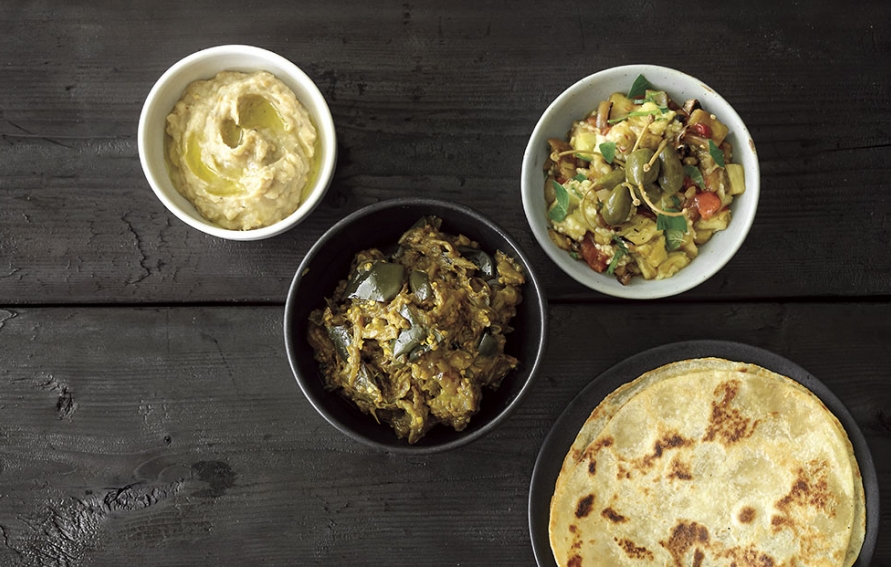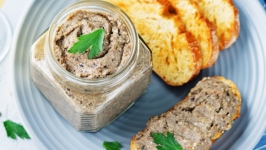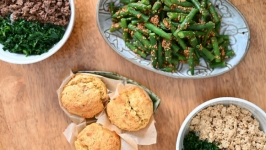Cooking
Eggplant Curry
After culinary school, my first full-time job was in the kitchen at Provence Mediterranean Grill in Vancouver's Point Grey neighbourhood. At the restaurant, many of my back-of-house coworkers were among the Tamil minority who had immigrated to Canada, fleeing the Sri Lankan civil war in the late 1980s. Manjula Kumar was one of them. On a particularly slow day, Kumar, who was the daytime dishwasher, came up to the line and asked if she could make us a snack. She made us this eggplant curry, the kind she would make for her family every Sunday following church. I didn't grow up eating much, if any, eggplant, so at the time, this dish was a taste revelation for me. I would ask her to make it whenever we had the chance and I would carefully watch, trying to quantify the ingredients as she didn’t have a written recipe, just the knowledge that had been passed on for generations.
1 large eggplant, cut into 3/4-inch cubes (approximately 5 cups)
1½ cups yellow onion, peeled and thinly sliced
1 clove of garlic
1 tablespoon, plus 1 teaspoon curry powder
1 tablespoon tamarind paste
Chili flakes (optional)
3 tablespoons canola oil
Salt
Once your eggplant is cubed, place into a mixing bowl and toss with a generous pinch (about a teaspoon) of salt. Transfer the eggplant into a colander and set inside the bowl to let the eggplant drain. Let sit for approximately one hour.
Once the eggplant has weeped, place it onto a large kitchen towel and pat dry. Discard the water from the mixing bowl and wipe dry. Place the eggplant back into the mixing bowl with two tablespoons of oil and 1 tablespoon of curry powder. Mix well.
Preheat your oven to 350F.
Place the eggplant onto a baking sheet (be sure to add any oil and seasoning that settled to the bottom of the mixing bowl) and cook for 30 to 40 minutes or until the eggplant is soft and has started to brown slightly.
While the eggplant is cooking, warm one tablespoon of oil in a large frying pan over medium heat. Add the onions and garlic and cook until the onions are well coloured, about 15 to 20 minutes. Turn the heat down if the onions start to colour too quickly and are sticking to the pan. Remove the pan from the heat while you wait for the eggplant to finish.
In a small pot over medium-low heat, add the tamarind paste and two to three tablespoons of water. Warm the paste slowly and stir until the paste has thinned to a ketchup-like consistency (add a little more water, if necessary). Place a mesh strainer over a bowl and spoon the thinned tamarind paste into the strainer and push gently to remove any seeds or skin.
Remove the eggplant from the oven and add to the cooked onions to the pan. Add the tamarind, the extra one teaspoon of curry powder and the chili flakes (if you like a little heat). Cook this mixture over low heat, covered, for another 20 minutes. Stir often and if the mixture starts to dry and stick to the pan, add a couple spoonfuls of water. Check the seasoning and adjust with salt and a pinch of pepper.
This curry is best served warm with Sri Lankan roti, but you can substitute for other flatbreads.
Charred eggplant and white bean dip
This dip is super simple and versatile. A small change to the ingredient list makes a whole new dip. Feel free to try items such as tomatoes, olives, herbs, roasted peppers, a can of tuna, and spices such as turmeric, za'atar, sumac or a bit of roasted vegetable purée. This dip is yours with which to experiment.
2 cups white beans — navy, cannellini or kidney, cooked or canned
2 cups charred eggplant
2 cloves of garlic, lightly roasted
1 tablespoon lemon juice
1/4 cup olive oil, plus 2 tablespoons
1 tablespoon smoked paprika (optional)
1 teaspoon salt
Pepper
Using the charred eggplant directions (see Charred Eggplant with herb and garlic vinaigrette recipe), cook off one to two large eggplants. Peel them and remove the stem ends. Dice the eggplant into pieces. Save the extra eggplant, if any, for another recipe (or just add it all to this one.)
Add the white beans, charred eggplant and garlic into a food processor and blend. Add in the lemon juice, 1/4 cup of oil and salt and pepper to taste.
To serve, spoon the dip into a bowl and top with the extra two tablespoons of oil and smoked paprika. Serve with slices of bread or flatbreads.
Caponata
Caponata is traditionally a Sicilian eggplant salad, soured with vinegar or lemon juice. We've turned this recipe into a dip, but you can serve it any way you like. It still works as a side salad or as a condiment to top sausages or grilled meats.
2 cups charred eggplant
1½ cups charred tomatoes
½ cup charred onion, red or yellow
¼ cup green olives, chopped
1/3 cup olive oil
2 tablespoons lemon juice or vinegar
1 teaspoon oregano, chopped
1 tablespoon parsley, chopped
1 tablespoon capers, chopped or 6-8 caper berries
Pinch of chilies (optional)
Salt and pepper
Using the charred eggplant directions, char one to two large eggplants. Peel them and remove the stem ends. Dice the eggplant into half-inch pieces.
While the eggplant is cooking, you can also cook a few tomatoes and the onion on the barbecue. Use tomatoes of varying sizes and colours to add interest to the final product. Leave the tomatoes on the heat until the skin starts to blister and the tomato has softened. Cut the onion into 1/4-inch slices. Place over the heat until the exterior of the onion is charred. Remove all from the heat and allow them to cool before cutting. Peel any bits of skin from the tomatoes. Once cooled, cut into small pieces.
Add all the ingredients into a mixing bowl and with a spoon or spatula, mix them together gently. Season to taste with salt and pepper and let stand for at least 30 minutes before serving to allow the flavours to mingle.
Serve at room temperature with chunks of good crusty bread.








